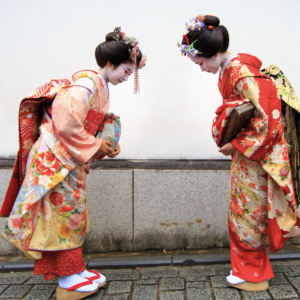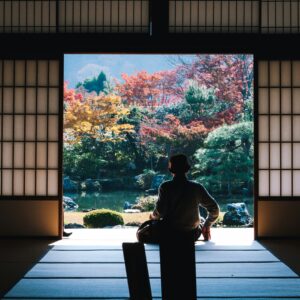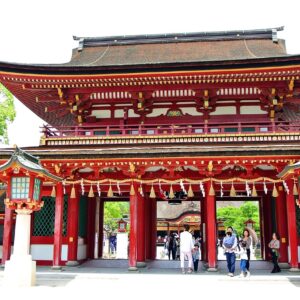Onsen Etiquette: How to Enjoy Japan’s Hot Springs Properly
Table of Contents
Soaking in an onsen (hot spring) is a quintessential Japanese experience, offering relaxation and a connection to nature. But before you dive in, there are important customs and rules to follow. Understanding onsen etiquette ensures a smooth and enjoyable experience for you and other bathers.
Here’s a guide to onsen etiquette in Japan—how to enjoy hot springs like a local while respecting Japanese traditions.
The Basics of Onsen Etiquette
1. Shower Before Entering
Hygiene is paramount in Japanese onsen culture. Before stepping into the communal bath, you must wash your body thoroughly. Showers are provided in the changing or bathing area, equipped with soap, shampoo, and a small stool. This practice reflects the Japanese emphasis on cleanliness and respect for communal spaces.
Showers are provided in rows of stations, each with a small stool, handheld shower, and toiletries. Bathers sit quietly, scrubbing themselves while water flows freely to rinse away soap.
2. Keep Towels Out of the Water
You’ll typically be given two towels: a large one for drying and a small one for bathing. The small towel can be used to cover yourself modestly while walking to the bath, but it should never touch the water. This rule ensures the water remains clean for everyone. Place the towel on your head or the edge of the bath instead.
3. Swimwear is Not Allowed
Onsens are meant to be enjoyed in the nude. While this may feel intimidating at first, it’s a deeply ingrained part of the experience in Japan. Nudity is seen as a way to equalize everyone, emphasizing harmony and comfort. Most facilities have separate baths for men and women, so privacy is maintained.
Many outdoor baths (rotenburo) are surrounded by nature, where steam rises from the water, creating a serene atmosphere as bathers relax with their small towels placed neatly on the rocks.
4. No Diving or Splashing
Onsens are places for quiet relaxation. Avoid splashing water or making loud noises, as this disrupts the peaceful atmosphere. Silence or soft conversation is appreciated to maintain the tranquil setting.
5. Respect the No-Tattoo Rule
Some onsens restrict entry to people with tattoos due to cultural associations with organized crime. However, many modern establishments have relaxed this rule, especially in areas popular with international visitors. Research tattoo-friendly onsens in advance or consider private baths if you have visible tattoos.everything on your plate is a sign of respect for the food and the person who prepared it.
Understanding Onsen Rules
1. Follow the Facility’s Instructions
Each onsen may have its own unique rules, often displayed at the entrance or bathing area. Take a moment to read them or ask staff if you’re unsure. Clear signage ensures that all visitors can follow the etiquette.
2. Bring Your Own Towel or Rent One
While many onsens provide towels, some require you to bring your own. Checking in advance prevents inconvenience, especially at smaller or more traditional facilities.
3. Don’t Bring Food or Drinks
Eating and drinking in the bathing area is generally not allowed. Onsens are spaces of relaxation, and keeping food and beverages out of the baths preserves this atmosphere. Refreshments are best enjoyed in designated areas after your soak.
Near the exit, you’ll often find small cafés or vending machines where you can enjoy a cold bottle of milk—a beloved post-onsen tradition among locals.
4. Tie Up Long Hair
If you have long hair, use a hair tie or clip to keep it out of the water. This maintains cleanliness and ensures that everyone can enjoy the bath without distractions.
5. Leave Valuables in Lockers
Most onsens provide lockers for storing personal items. Keeping valuables secure allows you to relax fully during your visit.
What to Expect in Japanese Onsens
1. Gender-Segregated Baths
Most public onsens have separate bathing areas for men and women. Look for signs or colors indicating the designated section: blue for men and red for women are common. This separation ensures privacy and comfort for all visitors.
2. Natural Scenery
Many onsens are situated in scenic locations, such as mountains, forests, or near the ocean. Outdoor baths (rotenburo) often provide stunning views, enhancing the sense of relaxation and connection to nature.
3. Soaking Temperatures
Onsen water can be quite hot, typically between 37°C and 42°C. Take your time entering and exiting to acclimate your body, especially if you’re not accustomed to high temperatures.
4. Mineral-Rich Waters
Onsen water often contains minerals like sulfur, iron, or magnesium, believed to have therapeutic benefits. Each onsen may specialize in specific mineral compositions, so exploring different locations can be a rewarding experience.
5. Relaxation Areas
After soaking, most facilities have relaxation areas with tatami mats or lounge chairs where you can unwind. These spaces often include complimentary tea or water stations to rehydrate.
After soaking, unwind in cozy tatami rooms with warm lighting and a tea station, where you can quietly enjoy complimentary tea or water to rehydrate.
Tips for First-Time Onsen Visitors
1. Visit During Off-Peak Hours
Early mornings or weekday afternoons tend to be less crowded, providing a more serene experience. This is especially helpful for those new to the onsen culture.
2. Start with a Private Onsen
If you’re nervous about communal bathing, many ryokans (traditional inns) offer private onsen options for families or couples. These provide the same benefits with added privacy.
3. Hydrate Before and After
Soaking in hot water can be dehydrating. Drink plenty of water before and after your visit to stay comfortable and refreshed.
4. Avoid Shaving Right Before
Shaving can leave your skin sensitive to the minerals in onsen water, causing irritation. It’s best to shave the day before your visit to ensure comfort.
5. Observe and Learn
Watch how locals behave in the onsen. Mimicking their actions is a great way to learn the etiquette and show respect for Japanese culture.
FAQs About Onsen Etiquette
1. Can I Wear a Swimsuit in the Onsen?
No, swimsuits are not allowed in traditional Japanese onsens. Bathing is done nude, with separate facilities for men and women. This tradition emphasizes cleanliness and equality.
2. What If I Have Tattoos?
Some onsens allow tattoos, while others don’t. Look for tattoo-friendly establishments or consider using waterproof tattoo covers if needed. Private baths are also a good alternative.
3. Are Children Allowed in Onsens?
Yes, children are generally welcome, but they must follow the same etiquette. Parents should ensure that children remain quiet and respectful to other bathers.
4. Can I Bring My Own Toiletries?
Yes, you can bring your own soap and shampoo, but most onsens provide these in the shower area. Bringing familiar products may enhance your comfort.
5. What Should I Do If I’m Unsure About the Rules?
If you’re unsure, ask the staff or observe other bathers. Many onsens have multilingual signs to help foreign visitors understand the etiquette.
Final Thoughts
Exploring Japan’s hot springs is a unique and rejuvenating experience, but following onsen etiquette is essential to fully enjoy it. By respecting the rules and customs, you’ll create lasting memories while blending seamlessly into this cherished aspect of Japanese culture.
So, prepare to soak, relax, and let the healing waters of Japan’s onsens leave you refreshed and inspired.
Looking for a tour agency to help with your planning?
Contact Firefly Japan to book a private luxury tour in Tokyo & Kanto


